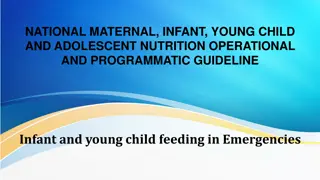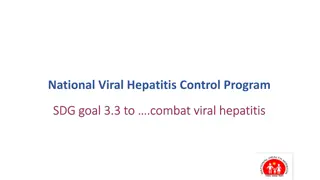Mainstreaming NTD Morbidity Management into Health Insurance Schemes
Explore opportunities for integrating NTD morbidity management into national health insurance schemes for improved universal health coverage. Discuss sustainable practices, data collection, and service capacity building.
1 views • 11 slides
Analysis of Listeriosis Rates in Europe 2017-2022
The data presents Listeriosis rates in various European countries from 2017 to 2022, showing cases and rates per country. The information reflects trends in foodborne diseases and highlights differences in morbidity and mortality rates across nations.
0 views • 17 slides
Enhancing Maternal Health: AMPLI-PPHI's Efforts in PPH Prevention and Management
AMPLI-PPHI, led by Michael Muthamia, aims to reduce maternal mortality and morbidity by promoting the adoption of new PPH prevention and treatment drugs. The program focuses on heat-stable carbetocin, tranexamic acid, and misoprostol, aiming to overcome supply-side barriers and shape markets. Target
1 views • 13 slides
Understanding Multidrug Resistance in Bacterial Infections
Multidrug resistance refers to organisms resistant to multiple antibiotics, impacting therapy decisions, increasing morbidity and mortality, and raising healthcare costs. Monitoring resistance profiles can aid in tracking outbreaks, with molecular typing confirming issues. Join the WHONET Webinar Se
0 views • 35 slides
Importance of Single Unit Red Blood Cell Transfusion According to Patient Blood Management Guidelines
Implementing single unit red blood cell transfusion based on patient blood management guidelines is crucial to minimize risks associated with transfusion, such as morbidity, mortality, and length of stay. By following these guidelines, healthcare providers can make informed decisions, reduce unneces
4 views • 18 slides
Guidelines for Treating Chronic Hepatitis C Virus Infection
Clinical guidelines provide evidence-based recommendations for treating and curing chronic HCV infection in adults to improve treatment rates, reduce morbidity and mortality, and support the New York State Hepatitis C Elimination Plan. Recommendations include considerations in HCV treatment initiati
2 views • 28 slides
Nursing Care for Ventilator-Associated Pneumonia (VAP)
Ventilator-Associated Pneumonia (VAP) is defined as lung parenchyma inflammation occurring 48 hours or more after endotracheal intubation and mechanical ventilation initiation. It is a common nosocomial infection in ICU patients, with significant morbidity and mortality rates. Etiology of VAP involv
2 views • 24 slides
Understanding Epidemiological Perspective: Definition, Scope, and Uses
Epidemiology is the scientific study of health-related states and events in populations, focusing on their distribution and determinants. This field helps in analyzing disease frequency, incidence, prevalence, mortality, and morbidity rates. Epidemiologists also examine disease distribution over tim
0 views • 29 slides
Understanding the Hookworm Superfamily Ancylostomatoidea
The superfamily Ancylostomatoidea includes blood-feeding parasites like hookworms, with important species such as Ancylostoma caninum in dogs and Ancylostoma duodenale in humans. These parasites have a complex lifecycle involving transmission through the environment and development within the host.
0 views • 31 slides
Understanding Social Determinants of Health
Chronic conditions like heart disease and cancer have multiple causes, not all biological. Social epidemiology studies the social distribution of health, morbidity, and mortality risk influenced by social status and conditions. Factors such as age, gender, race, socioeconomic status, and social cond
0 views • 32 slides
Developing Cardiovascular Screening Measures for Pregnant and Postpartum Women Project
Cardiovascular disease (CVD) is a leading cause of maternal mortality in the US, with disparities in morbidity. Standardizing evaluation and triage is crucial. Preventability studies show a high potential for identifying at-risk cases. The CVD Toolkit aims to enhance awareness and readiness among he
1 views • 17 slides
Maternal and Child Health Indicators: Objectives and Mortality Rates
Maternal and Child Health (MCH) services aim for the reduction of maternal, perinatal, infant, and childhood mortality and morbidity, promotion of reproductive health, and physical and psychological development of children and adolescents within families. The indicators focus on mortality rates, inc
0 views • 31 slides
Importance of Preconception Care for Maternal and Child Health
Preconception care involves biomedical interventions provided to women and couples before conception to improve their health status and reduce factors contributing to poor maternal and child health outcomes. It aims to enhance maternal and child health in both the short and long term by addressing p
0 views • 14 slides
Understanding Psychosis in Older Adults
Psychosis in older adults presents unique challenges due to varied etiology, different presentations, and higher associated morbidity. Causes include medical conditions, psychiatric disorders, and certain medications. Delirium, depression, and dementia are common contributors to psychosis in the eld
0 views • 12 slides
POSNOC & ATNEC Trials Update by Amit Goyal: Investigating Axillary Treatment in Breast Cancer
POSNOC (Positive Sentinel Node) and ATNEC trials are investigating the effectiveness of axillary treatment in women with early-stage breast cancer having metastases in one or two sentinel nodes. Led by Chief Investigator Amit Goyal in the UK, this randomized controlled trial compares adjuvant therap
1 views • 21 slides
Understanding Vital Statistics and Health Information Management
Vital records encompass crucial life events such as births, deaths, and marriages, forming the basis of vital statistics. These statistics serve to quantify and analyze various aspects of health, including mortality, morbidity, and population dynamics. Health Information Systems play a pivotal role
1 views • 30 slides
Healthcare Preparedness for COVID-19 Outbreak - Exercise Objectives
Provide an opportunity to evaluate response concepts, plans, and capabilities for handling a novel viral disease outbreak. Objectives include minimizing morbidity, preserving social function, and improving hospital preparedness. Focus on surveillance, infection control, healthcare guidance, and comm
0 views • 26 slides
Division of Cardiology Morbidity & Mortality Conference Summary
The Division of Cardiology's Morbidity & Mortality Conference discussed a case involving a patient with an LVAD presenting with "low flows," a delayed diagnosis of GIB, and delayed transfusion. The level ofCONTENT for the corresponding Medical Record Number (MRN) includes a timeline of events that l
0 views • 14 slides
Pediatric Oral Health in Cancer Therapy: Strategies and Complications
Pediatric patients undergoing cancer therapy face increased risks of oral health complications due to immunosuppression, including oral infections and tissue trauma. These can compromise treatment effectiveness, leading to higher morbidity, mortality, and healthcare costs. Strategies for assessing a
0 views • 12 slides
Understanding Ephemeral Fever/Three-Day Sickness in Cattle and Water Buffalo
Ephemeral fever (Three-Day Sickness) is an acute arthropod-borne viral disease affecting cattle and water buffalo. It is caused by the Bovine Ephemeral Fever Virus and manifests with biphasic fever, decreased milk yield, and other clinical signs. The disease has varying prevalence and can lead to hi
0 views • 7 slides
Importance of Nutrition in the Context of HIV and TB
Malnutrition is common in people living with HIV and TB, exacerbating immune suppression and disease progression. Good nutrition can strengthen the immune system, improve drug adherence, and manage symptoms, while poor nutrition weakens immunity and increases vulnerability to infections. Consequence
2 views • 20 slides
Comparison of Erector Spinae Plane Block vs Serratus Anterior Plane Block in Thoracic Surgery Recovery
Minimally Invasive Thoracic Surgery often results in severe post-operative pain, typically managed with the Serratus Anterior Plane (SAP) block. This study compared the quality of recovery and morbidity between SAP and the relatively new Erector Spinae Plane (ESP) block. Results showed that ESP prov
1 views • 10 slides
Understanding Cerebral Edema: Causes, Treatments, and Pathophysiology
Cerebral edema is a life-threatening condition that can result from various factors such as trauma, infarction, hemorrhages, or tumors. This condition can lead to increased morbidity and mortality due to hemorrhage or herniation. New advances in understanding the pathophysiology of cerebral edema ha
1 views • 28 slides
West Sussex HIV Testing Plan: Strategies for Improved Diagnosis and Treatment
West Sussex's HIV testing plan for 2022-2025 focuses on reducing domestic transmissions by implementing targeted strategies in primary and secondary care settings. While overall prevalence is low, certain areas in West Sussex exhibit higher rates, necessitating tailored testing approaches. The plan
0 views • 6 slides
Understanding Frailty in Geriatric Care
Frailty in older adults is a clinical state of vulnerability with risks for adverse outcomes. It is distinct from old age or morbidity and requires careful identification due to its association with adverse events. Screening for frailty is crucial to target interventions effectively and improve pati
0 views • 23 slides
Infant and Young Child Feeding in Emergencies: Operational Guidelines
Infant and Young Child Feeding in Emergencies (IYCF-E) focuses on protecting and supporting safe feeding practices for infants and young children during all types of emergencies to reduce mortality and morbidity risks. Key actions include developing policies, training staff, coordinating operations,
4 views • 10 slides
Maternal Nutrition Guidelines for Optimal Health Before and During Pregnancy
Recommended maternal nutrition practices play a crucial role in preventing nutrition deficiencies in both mothers and infants, improving fetal outcomes, and reducing morbidity and mortality rates. Preconception care emphasizes the provision of health interventions to women and couples before concept
0 views • 14 slides
Understanding Intestinal Obstruction: Causes, Classification, and Pathophysiology
Intestinal obstruction can be classified into dynamic and adynamic types, with various causes such as intraluminal faecal impaction, malignancy, and hernia. The pathophysiology involves changes in bowel peristalsis and dilation, leading to potential strangulation and ischemia. Morbidity and mortalit
9 views • 40 slides
Understanding Bipolar Disorder in Older Adults
Bipolar disorder in older adults can have a later onset, often after the age of 50, with episodes of mania and depression. Recognizing symptoms like excessive energy, inability to sleep, and cognitive impairment is crucial. Late-onset bipolar disorder differs from early-onset in familial illness rat
1 views • 12 slides
Clinical Practice Guidelines for Rhabdomyolysis: Management and Recommendations
Rhabdomyolysis is a condition with a significant impact on kidney function, requiring prompt clinical management to prevent morbidity and mortality. This article discusses the prevalence, patient population criteria, admission criteria, treatment options, and potential complications associated with
1 views • 13 slides
Understanding Antiviral Chemotherapy: Importance and Types
Antiviral chemotherapy plays a crucial role in preventing and treating viral infections, especially when public health measures and vaccines are not sufficient. This form of treatment has been successful in combating diseases like HIV by inhibiting viral replication and targeting specific functions
1 views • 34 slides
Overview of Antibacterial Sulfonamides in Pharmaceutical Chemistry
Antibacterial sulfonamides were the first effective chemotherapeutic agents used systemically to cure bacterial infections in humans, leading to a decline in infectious disease morbidity. Despite rapid resistance development, they still find use in opportunistic infections, with limited applications
0 views • 16 slides
Understanding ICD-11 and Morbidity Coding Principles
ICD-11 is a classification system that groups entities based on statistical relevance and specificity of codes. Entities without specific codes are assigned to residual codes (Y for specified, Z for unspecified) based on hierarchy. Examples illustrate the differentiation between specified and unspec
0 views • 15 slides
Understanding Breech Presentation in Pregnancy
Breech presentation in pregnancy occurs when the baby is positioned buttocks or feet first instead of head first, which can complicate delivery and increase risks of perinatal mortality and morbidity. This article covers the types of breech presentation, symptoms, causes, diagnosis, management, and
9 views • 21 slides
Overview of Malignant Catarrhal Fever in Cattle and Other Species
Malignant catarrhal fever (MCF) is a fatal disease affecting various species, caused by two different viruses transmitted from wild animals. It is characterized by low morbidity but high mortality rates, with distinct clinical signs such as sudden death, head and eye manifestations, and intestinal i
0 views • 24 slides
National Viral Hepatitis Control Program - Achieving Universal Health Coverage and Elimination Goals
The National Viral Hepatitis Control Program in India is working towards combating viral hepatitis and achieving SDG goal 3.3 through a comprehensive approach that includes awareness generation, prevention, management, and financing under the NHM. The aim is to eliminate hepatitis C by 2030, reduce
0 views • 19 slides
Understanding Intergenerational Consequences of Malnutrition
Exploring the short-term and long-term impacts of malnutrition on mortality, morbidity, disability, cognitive development, health, and economic productivity. Investigating the underlying and immediate causes such as inadequate dietary intake, disease, household food insecurity, and inadequate food,
2 views • 16 slides
Understanding Trends in Mortality and Morbidity in India
The paper discusses the perplexing rise in morbidity alongside improvements in various health and socioeconomic indicators in India. It explores the complex relationship between mortality and morbidity and the need for a combined macro and micro research approach to gain fresh insights into the issu
0 views • 41 slides
Addressing Maternal Morbidity and Mortality in KwaZulu-Natal, South Africa: A Multi-Staged Approach
This study focuses on reducing maternal morbidity and mortality rates in KwaZulu-Natal, South Africa, which remain unacceptably high. The research by Firoza Haffejee and Nokuthula Sibiya highlights the need for a comprehensive, multi-disciplinary healthcare strategy to tackle the various factors con
0 views • 31 slides
Understanding Multi-morbidity and Deprivation in UK General Practice
Exploring the association between multi-morbidity, deprivation, and life expectancy in the context of UK general practice. The research aims to quantify socio-economic inequalities in chronic disease onset and life expectancy, particularly among older populations with multi-morbidity. Methods includ
0 views • 27 slides







































